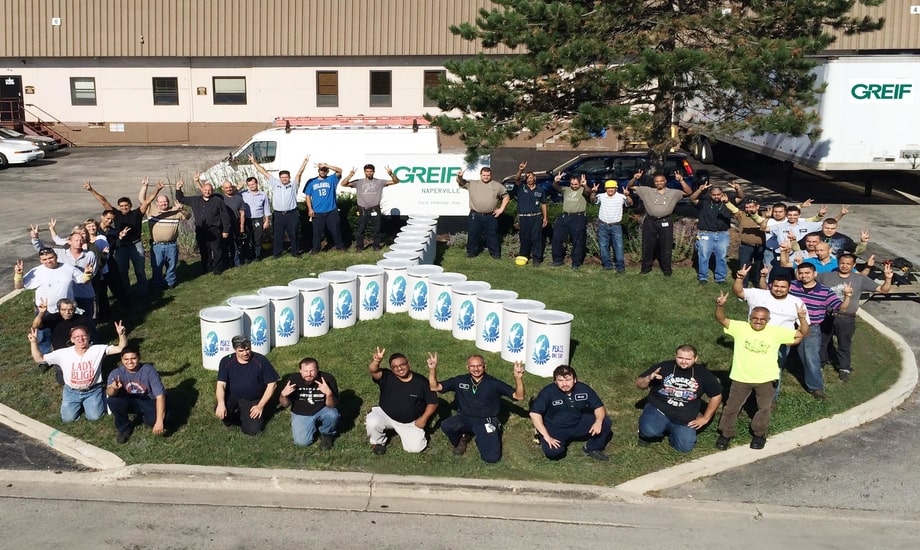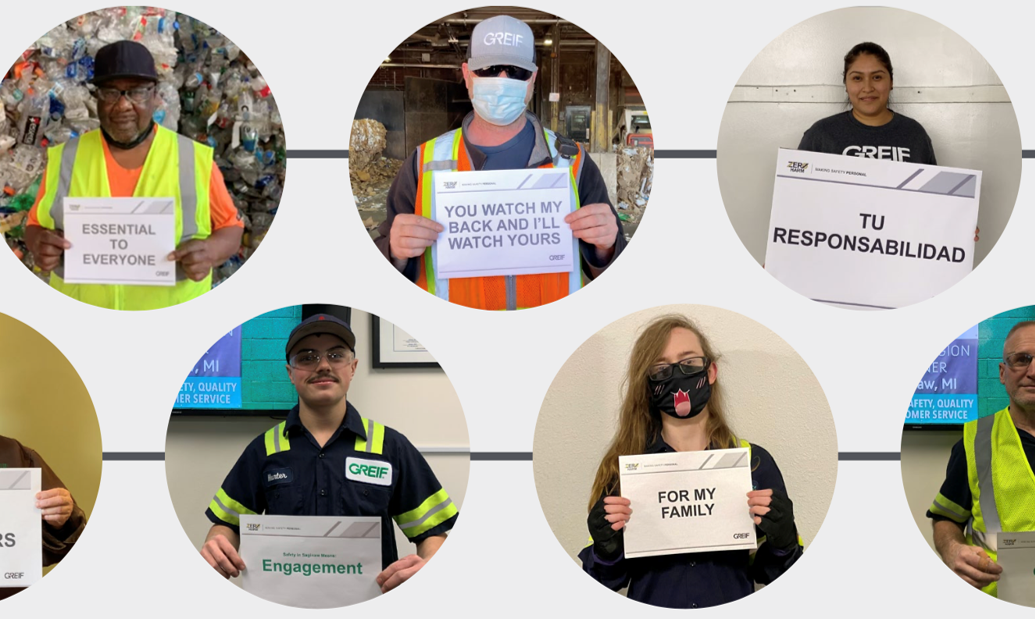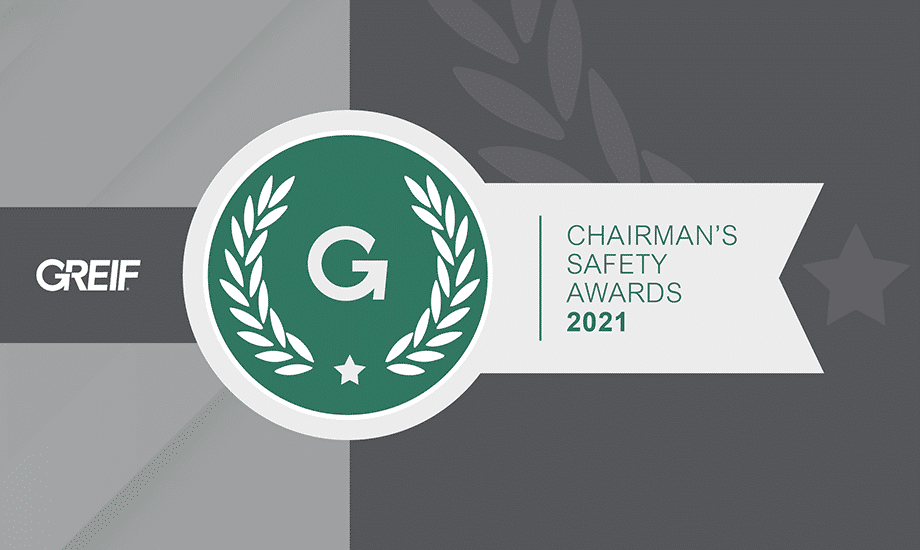- Sobre nossa empresa
- Sobre o nosso relatório
- Estratégias de Sustentabilidade
- Metas e Desempenho
- Índices de relatórios ESG
- Relatório de downloads
Why Health & Safety Matters
Governança
Our Safety Leadership Team, led by our Senior VP of Global Operations Group and comprised of representatives from each region and strategic business unit, manages our global EHS policy and is responsible for driving progress on policies, programs and initiatives to support a culture of safety at Greif. Our strong safety culture and management begins with and is led by our Executive Leadership Team and is the responsibility of every manager within Greif. To ensure our policies fairly represent the entirety of our workforce, 100 percent of our workforce is represented by safety committees comprised of colleagues and management at all our production facilities.
Our global Saúde e Segurança Ambiental (EHS) Policy provides the structure and standards that enable our safety culture. We supplement our global EHS policy with business unit-specific EHS policies for all facilities, further strengthening our commitment to safety. Every two years, we conduct third-party audits at each facility to ensure compliance with all laws, regulations and policies. We use our Compliance Management System (CMS) to track health and safety tasks, including safety observations, incidents and close calls at the facility level. Our 20 global policies apply to all union and non-union colleagues in our workforce. Our Política de Segurança do Contratante makes provisions for the safety of our contractors.
We formed our Serious Injury and Fatality (SIF) global workgroup in 2016 to analyze industry research regarding SIF events and methods of advancing our program. Based on their work, we introduced the Life Changing Injury and Fatality Elimination (LIFE) program in 2017 to better understand and track close calls and potentially life-altering, life-threatening and life-ending safety events. Through LIFE we have raised awareness and implemented programs to address critical safety behaviors at each of our facilities, such as suspended load-related safety, lockout-tagout procedures and enhanced machine guarding. The program led to the introduction of our PIT-Pedestrian Policy, which helps to safeguard our colleagues against the dangers of industrial truck operations, the event with the highest risk of a LIFE injury in Greif’s facilities. In 2019, we used our LIFE data to identify global and regional leading indicators and develop safety action plans to address the highest risk injury events. In 2020, we replaced the risk index with an improved LIFE metric and implemented corrective actions tracking for LIFE events. We have also implemented a process to share all medical cases and LIFE events using the Situation Behavior Impact (SBI) format on a one-page document across all our Global Industrial Packaging (GIP) business unit.
16.4
Average Safety Training Hours
Each production colleague in our business receives safety training, ensuring our safety culture is understood and practiced every day.
This year, we introduced our Zero Harm safety commitment, which goes beyond avoiding incidents and injuries. Zero Harm is about each employee going home better than they arrived at work. Zero Harm is a positive mindset and awareness of safety that runs through every aspect of our work. In conjunction with Zero Harm, we have aligned our regions and shifted toward a global management approach to safety in an effort to become one Greif. We introduced new trainings and expanded existing trainings available globally. In 2021, we delivered 16.4 hours of safety training per production colleague. We also debuted “Target Zero,” a quarterly colleague newsletter that communicates safety-related news, best practices and advice to our colleagues while aggregating updates and highlights from our facilities around the world.
In 2021 we introduced a standardized training calendar in North America. We update the training calendar regularly to ensure every plant is receiving the same training each month. We also utilize our Greif QS in all our plants to standardize the way we log and report incidents. This allows us to run incident analyses to identify trends and work to mitigate recognized risks.
In 2021 we introduced a standardized training calendar in North America. We update the training calendar regularly to ensure every plant is receiving the same training each month. We also utilize our Greif QS in all our plants to standardize the way we log and report incidents. This allows us to run incident analyses to identify trends and work to mitigate recognized risks.
Our annual safety leadership training helps our leaders establish a stronger safety performance culture and encourage all colleagues to be accountable and keep themselves and others safe. The training was available to GIP professionals and plant managers, with plans to expand the training to the colleague level next year. We are currently in the process of offering our trainings in 20 languages to make them accessible to as many colleagues as possible. The leadership training provides our safety leaders with the knowledge and resources to reinforce the importance of safety to colleagues, address safety issues and be alert to risks and successfully facilitate meaningful dialogue through our Commitment-Based Safety / Quality (CBS/Q) program. The CBS/Q program highlights the value of daily safety.
In September 2021, we held our annual Safety Week, attended by the Executive Leadership Team and external speakers. Colleagues from facilities, offices and remote working arrangements globally, took part in safety-related exercises. During Safety Week, we reinforced colleagues’ understanding of safety basics, provided opportunities to share best practices and strengthened our approach to safety leadership. We also held our Safety Leadership Conference, attended by 367 of our most impactful leaders where we encouraged leaders to promote a safety culture emphasizing Zero Harm.
At the start of each day or shift, teams begin with a 15-minute discussion around safety and quality, encouraging a safety and quality culture within the work teams. The meetings provide a daily opportunity for colleagues to talk openly about any concerns and creates an environment where proactive safety behaviors are valued. Teams identify potential safety hazards within their job function, articulate and rank their safety performance and make pledges to take responsibility for their actions.
Colleagues participate in TAKE2, a safety management process to encourage colleagues to “take two minutes” to think about the non-routine task, personal actions, equipment and potential hazards involved when performing a task that is not part of their normal workday. Colleagues then complete and sign a TAKE2 analysis. TAKE2 allows colleagues to stop and ensure they are thinking of not only their own safety, but also the safety of their colleagues. The last step involves a lead person, supervisor or manager, signing the TAKE2 analysis before the colleague is allowed to begin the non-routine task. Through this program, we also place an increased focus on safety risks our colleagues may face at home that are relevant to the workplace, and vice versa.
We continue to utilize a nurse hotline service, to streamline our colleague’s access to medical care and guidance. When an incident happens at any facility in North America, a team member calls the nurse hotline to discuss the severity of the injury and obtain advice as to whether the individual should seek further treatment. If colleagues ever request to see a doctor, we take them to visit a doctor immediately.
Our Global Safety Scorecard and visual standards help promote consistent safety metrics globally. The Scorecard standardizes metrics within each business unit to ensure we are evaluating safety similarly across all our operations, but considers business- and facility-specific safety risks that drive global metrics.
To promote a continuous focus on safety, Paper Packaging & Services (PPS) facilities hold weekly safety calls attended by all General Managers, senior leadership and other select colleagues from each facility. During the calls, each facility is responsible for reviewing any incidents that have occurred over the past week and there is rotating responsibility to share at least one best practice for promoting safety with the group. These calls have led to the adoption of innovative safety risk reduction and elimination solutions in every operation. The Mill Group also began a series of learning discussions in 2020 centered on Human Operational Performance, to better understand how factors such as human error can impact safety.
Sites within PPS have placed increased focus on pedestrian and mobile equipment interaction, lockout-tagout, machine guarding, job safety analysis and risk and hazard recognition as part of our continued efforts to embed a safety culture across all Greif facilities. We are also proud to continue some innovative safety practices from Caraustar’s legacy safety programs. For example, Caraustar had established a program across a number of sites that provides our colleagues with access to an athletic trainer to help them prevent and recover from both non-work-related and work-related injuries that may result from the physical demands of the job and at home. This program is currently in use at nearly half our mills and several select PPS facilities. In late 2020, PPS began piloting a virtual Athletic Trainer program to prevent ergonomic injury and illnesses. We started with smaller facilities and plan to expand its use over time. We currently have 11 sites using onsite Athletic trainers and 10 sites using virtual Athletic Trainers. We plan to expand this program to additional sites in 2022. The Industrial Products Group adopted an innovative solution that utilizes technology to analyze standard activities to identify ergonomic risks and modify workstation configurations and practices to eliminate conditions that can contribute to injury.
Our global health and safety efforts were more important than ever as we carefully worked to ensure the health and safety of our colleagues during the COVID-19 pandemic. At Greif, we provide critical and essential goods manufacturing and distribution, packaging and protecting goods and materials that serve the greater needs of communities around the world. Given our position as an essential business, we continued to operate throughout the pandemic across our global portfolio by adhering to local, state and national regulations in more than 40 countries. To ensure colleague safety in response to COVID-19, we established a global task force and multiple regional task forces, which meet at least weekly and more often as needed. Our task forces, and management at all levels, continuously monitor the impact of COVID-19 on our colleagues, communities and business continuity. In addition, we continued practicing the health and safety measures implemented in 2020 and 2021 including:
- Manter procedimentos rigorosos em todas as operações, como proibições de visitantes, com disposições extras em vigor para provedores de logística e subcontratados essenciais aos negócios
- Melhorar os protocolos de limpeza e higienização em todas as instalações e escritórios
- Melhorar os requisitos de EPI para garantir que os produtos do cliente não sejam tocados pelas mãos desprotegidas
- Fornecer aos colegas instruções e recomendações atualizadas sobre a melhor forma de otimizar as práticas de higiene pessoal, desinfecção e distanciamento social
- Escalonamento das equipes de produção quando necessário para reforçar ainda mais os requisitos de distanciamento social
- Incentivar colegas que não trabalham na produção a trabalhar em casa ou remotamente e apoiá-los nessa transição
Metas e Progresso
- Reduce Medical Case Rate (MCR) by 10 percent annually to achieve a MCR Zero in the long term.
- Cada planta terá um comitê colaborativo de saúde e segurança ambiental composto por gerentes e trabalhadores até o final do ano fiscal de 2025.
Desempenho
As of 2018, each Greif plant had a safety committee comprised of managers and colleagues. We are proud of the results that have come from our vigilance in health and safety.
We focused our efforts on facilities that were of higher risk for safety incidents. We implemented focused safety facility plans and reinforced goals and actions on the largest safety risks, and the risks that led to incidents at each facility. For example, all legacy Caraustar mills and a third of our Industrial Packaging and Recycling sites received a third-party safety audit in 2020. Results of the findings are shared across other sites with common solutions and improvements. Audits will continue across PPS in 2022. Since 2007, we have experienced a 58 percent reduction in MCR, improving from 3.51 to 1.49. Similarly, since 2011, Lost Workday Case Rate (LWCR) has improved from 1.3 to 0.74, a 43 percent reduction.
We remain steadfast in our commitment to safety and reaching the goals we have set for ourselves. We believe our overall safety strategy and the culture of safety that we have created in our organization is effective and provides the foundation we need to continue reducing MCR and LWCR in the coming years. We believe our Commitment-Based Safety/Quality, Behavior Based Safety Observation and TAKE2programs are critical in strengthening our commitment to our safety culture.
COLLEAGUE HEALTH & SAFETY
**LWCR, or Lost Workday Case Rate, measures the number of recordable injuries resulting in lost workdays per 100 full-time colleagues in a 12-month period.
Os dados de 2019 incluem a Caraustar apenas para março em diante – nenhum dado incluído para os primeiros 4 meses do ano fiscal.
Programa de Assistência ao Empregado (EAP)
Todos os colegas da Greif no Canadá e nos Estados Unidos têm acesso a um programa de assistência ao funcionário (EAP). O EAP da Greif é um programa confidencial de intervenção baseado no trabalho que oferece aos colegas e suas famílias serviços informativos projetados para melhorar o bem-estar emocional, mental e psicológico geral. O programa fornece intervenções preventivas e proativas para a detecção precoce, identificação e/ou resolução de problemas pessoais e de trabalho que podem afetar negativamente o desempenho e o bem-estar. Esses problemas e questões podem incluir, mas não estão limitados a, relacionamentos, saúde, trauma, abuso de substâncias, jogos de azar e outros vícios, problemas financeiros, depressão, transtornos de ansiedade, transtornos psiquiátricos, problemas de comunicação e enfrentamento de mudanças.

Comemorando operações sem acidentes de longo prazo
A aspiração de saúde e segurança de longo prazo da Greif é atingir zero acidentes em todas as nossas instalações no mundo todo. Embora reconheçamos o desafio dessa aspiração, 10 de nossas instalações da Global Industrial Packaging (GIP), incluindo os seguintes locais, atingiram dez ou mais anos de operações sem acidentes:
- Amaititlan, Guatemala – 14 years
- Midland Warehouse – 14 years
- Angarsk, Russia – 13 years
- Beloyarsky, Russia – 13 years
- Esteio, Brazil – 13 years
- Chino, USA – 13 years
- Volgograd, Russia – 13 years
- Vologda, Russia – 13 years
- Delta Cincinnati, USA -12 years
- Kazan, Russia – 12 years
- Manaus, Brazil – 12 years
- Mandra, Greece – 12 years
- Pioneer, Singapore – 12 years
- Rio de Janeiro – 12 years
- Huizhou, China – 11 years
- Mombasa, Kenya – 11 years
- Vung Tau, Vietnam – 11 years
- San Juan, Argentina – 10 years
- Delta Shanghai, China – 10 years
- Houston Plastic, USA – 10 years
Essas conquistas, assim como outras instalações com zero acidentes em 2023, fornecem modelos sólidos em apoio à nossa aspiração de zero acidentes em todas as nossas instalações no mundo todo.

Prêmio de Excelência em Segurança do Presidente
Cada instalação que atinge um MCR de zero ganha o Chairman's Safety Excellence Award. Globalmente, 97 de nossas instalações de produção receberam o prêmio em 2023 e foram reconhecidas em uma cerimônia virtual.

DESTAQUES DE SUSTENTABILIDADE
1.49
Medical Case Rate
Our Commitment-Based Safety/Quality, Behavior Based Safety Observation and TAKE2 programs illustrate our efforts to reduce MCR and LCWR across our operations.
16.4
Average Safety Training Hours
Each production colleague in our business receives safety training, ensuring our safety culture is understood and practiced every day.





